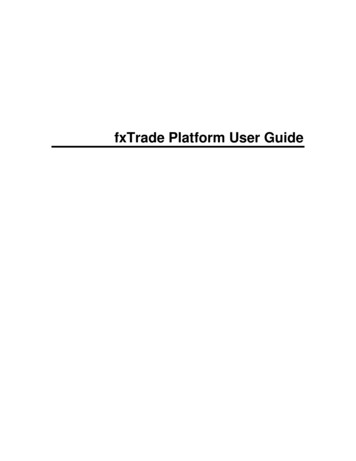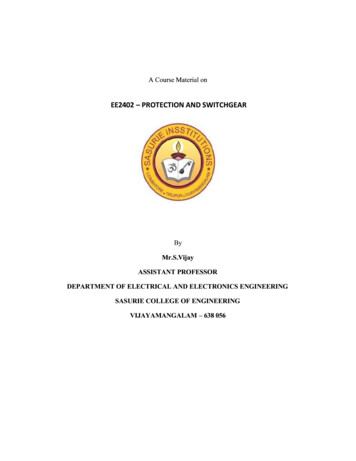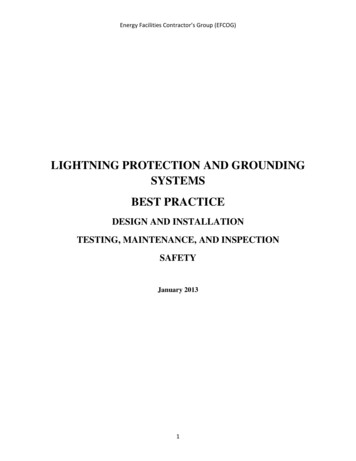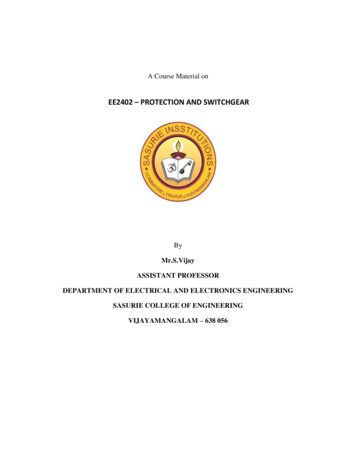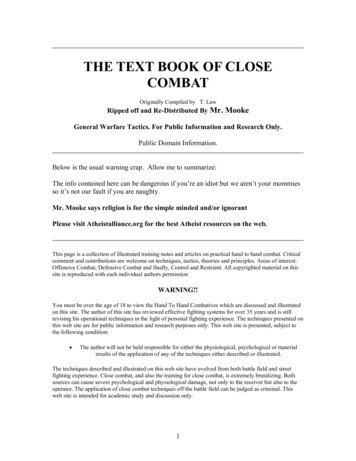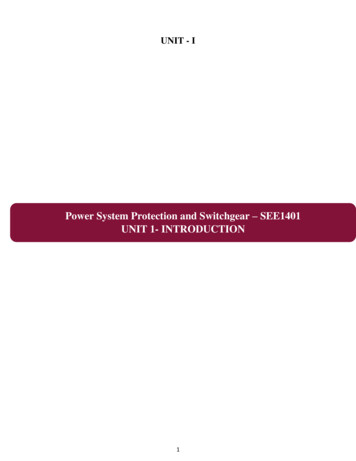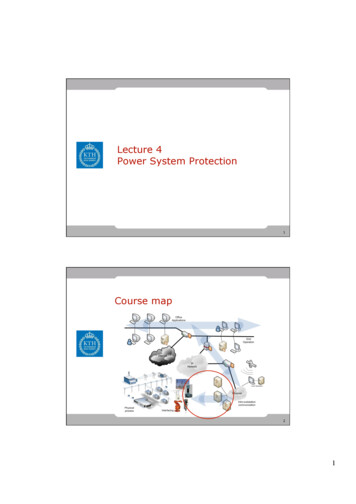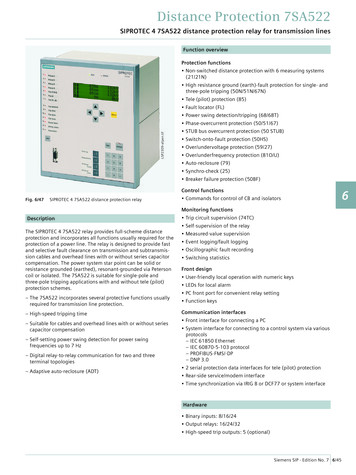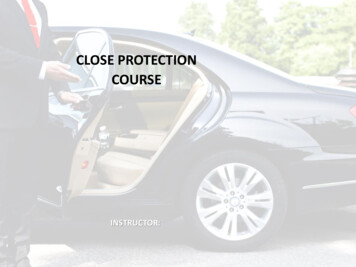
Transcription
CLOSE PROTECTIONCOURSEINSTRUCTOR:
C& HOSTILE ENVIRONMENT CLOSE PROTECTION COURSE DETAILEDTRAINING PROGRAMMEORPORATEKNOWLEDGE AND SCENARIOBASED TRAINING AND ASSESSMENTChapter 1: Roles and Responsibilities of the Close Protection OperativeChapter 2: Threat and Risk AssessmentChapter 3: Surveillance AwarenessChapter 4: Operational PlanningChapter 5: Law and LegislationChapter 6: Interpersonal SkillsChapter 7: Close Protection Teamwork and BriefingChapter 8: Conduct ReconnaissanceChapter 9: Close Protection Foot DrillsChapter 10: Route SelectionChapter 11: Close Protection Journey ManagementChapter 12: Search ProceduresChapter 13: Incident ManagementChapter 14: Venue Security.
INCIDENT MANAGEMENTSession One: Avoiding ConflictSession Two: Defusing ConflictSession Three: Resolving and Learning from ConflictSession Four: Application of Communication Skills.
The course will satisfy and meet the requirements of cognitive,theorist, affective and reflective styles of learning abilityThe candidates will be involved in discussion and practical type scenarioswhich are useful for informative assessment and time will be utilised forrevision and reflective summaryThe course will involve question and answer opportunities to ensure thecandidates have gained a clear understanding of each subject and arerefreshed in the relevant skills of a CPO and meet the requirements of theSIAThe course content will be taught by designated subject matter experts(SME’s) with vast operational and instructional backgrounds in their field ofexpertise.
NATIONAL OCCUPATIONAL STANDARDSPCP 1:Assess level of threats and risks to PrincipalsPCP 2:Plan and prepare to minimise threat and risk to PrincipalsPCP 3:Liaise and communicate with Principals and othersPCP 4:Establish and maintain secure environmentsPCP 6:Maintain the safety and security of Principals whilst on footPCP 7:Maintain the safety and security of Principals whilst in transitPCP 8:Maintain protection whilst drivingPCP 9: Use control and restraint to support close protectionPCP 10: Use physical intervention to support close protectionPCP 11:Respond to trauma and medical crisisPCP 12: Maintain personal security awarenessSLP 2:EMPLOYMENT NTOCommunicate effectively and efficiently in the workplaceSAS 8:Use IT to support own roleUNIT 3: Promote a healthy and safe workplaceUNIT 5: Give a positive image of your selfUNIT 6: Work effectively with other agencies.
CHAPTER 1INTRODUCTION TO THE ROLES AND RESPONSIBILITIES OF A CLOSEPROTECTION OFFICERAim: To introduce and explain the roles and responsibilities of theClose Protection Operative To introduce and explain the roles and responsibilities of theClose Protection Team.
TEACHING METHODS USED: Visual presentations in the form of Power-Point will supportthe learning Theoretical information will be provided in relevance tosubjects covered Practical scenarios will be undertaken by the trainee’s.
INTENDED LEARNING OUTCOMES:By the end of this session students will be able to: Explain the purpose and diversity of the Close Protection sector Give examples of notable Close Protection incidents; successes andfailures Explain the difference between a Client and a Principal within the roleof Close Protection Explain the different roles within a Close Protection Team Explain the roles a Close Protection Operative may undertakewhilst working alone State the professional attributes of an effective Close ProtectionOperative Explain the range of equipment available to the CloseProtection Operative.
Explain the purpose of Close Protection training and licensing State why it is necessary for a Close Protection Operative to beresponsible for their own Continual Professional Development(CPD) Give examples of the different types of people to whom CloseProtection Operatives are required to provide personalprotection and describe the different tasks involved Explain the need for a Close Protection Operative to be flexible andact in a professional manner during an assignment Explain how working alone affects how a Close ProtectionOperative carries out their role.
INTRODUCTION“A bodyguard is a person who protects someone known as theirPrincipal/Client/VIP/Customer. He or she will establish and maintaina safe working environment in which to protect the Principal fromassassination, personal assault, kidnapping, loss of confidentialinformation or other threats”.
Bodyguards have been around from the second century BC whenhousehold troops of the Cohorts praetorian were formed into thePraetorian Guard and used as personal bodyguards by Roman generals.In the late twentieth and early twenty-first centuries, most bodyguardswere police officers or soldiers either retired or current. Former membersof the Special Air service will, on leaving the regiment usually move intoclose protection, having gained training and experience in the role whileserving soldiersBecause of their reputation, training and experience former members ofthe SAS used to dominate “The Circuit” as the civilian Close Protectionworld is referred to, closely followed by former members of the Royalmilitary Police and civilian police trained protection officers.
However a police or military background is not essential for employmentbut will certainly be an advantage. Most new protection operative’s entryinto “The Circuit” is usually by recommendation. To be realisticallyemployable your training must have been with a reputable company, up todate and relevant. Because close Protection Officers are self-employed andrely heavily on networking a good reputation and training history isimportant. Contracts are usually short-term and are generally offeredthrough specialist operational CP companies.
Daily rates of pay vary according to the risks involved and range from 120 to 300 plus expenses per day. Salaries for Personal ProtectionOfficers (Bodyguards) start around 40k per annum. Overseasassignments in particular can significantly increase your earnings but therisks in some countries increase substantiallyThe first step to a new career in Close Protection is to research thecompanies offering training, paying particular attention to the credentialsof the training team, is the course and company recognised by the SIA.Many will fail to make it on to “The Circuit” simply because they chose thewrong training provider.
It is essential that time is spent researching the market and a fewquestions asked of the training provider before parting with yourhard earned cash such as, Is the company SIA approved?, Are theinstructors credentials genuine?, Is the course content relevant?,After the course what career support will I get?.
COURSE DURATIONThe Royal Military Police Close Protection Unit and Royalty CloseProtection team attend a basic course of at least 8 weeks, followed by4 weeks pre- deployment trainingEven after removing firearms training, physical fitness and specificMilitary/ Police elements, the minimum of entry-level training should beabout four weeks. Ideally this training should be carried out on acontinuous basis, to minimise skill fade and maximise effectiveness.
All CPOs wishing to conduct operations in the UK will require a licenceissued by the SIA, for more information on this subject you can visit theSIA web site at www.sia.homeoffice.gov.uk however during the courseyou will be updated on any changes in the SIA requirementsYou will be required to attend and successfully complete a First Aid atWork course or a suitable course indicated on the SIA web site. This is tomaintain a high standard of Close Protection Officers, skilled in allsubjects indicated by the SIA. It is also important to update your skills ona regular basis and work towards a degree in Close ProtectionConsideration should also be given to; a surveillance course, furthermedical qualifications, firearms, defensive driving, further education, etc.
An SIA licence last for three years and cost 220.00 which is notrefundable so ensure you have all the necessary documentationincluding a criminal background check.Essential Subjects are:1.CP Skills & Procedures2.Personal safety (PS)3. First Aid & Trauma Management4. Tactical Driving5. Surveillance and Counter Surveillance Planning and Risk AssessmentsNB: For overseas High-risk work, a CPO will also beExpected to be competent with firearms.
EMPLOYMENT OPPORTUNITIES AND CAREERDEVELOPMENTCompanies that promise to provide jobs at the end of a course should bescrutinised and viewed with suspicion, especially if they do not have anoperational division. Many people have been misled, completely let downor given inferior employmentReputable companies will maintain a database of trained personnel andwill actively support their students by arranging Interviews with reputablePrivate Security Companies affiliated to their Training Organisation. Otherssimply take the money and leave the newly qualified CPO to struggleagainst the odds alone. Usually because the Instructors have limitedexperience and credible contacts on the Circuit!.
Close Protection exists to provide security and reduce risks to publicfigures or anyone else who feel they are vulnerable for whatever reason.The purpose of this course is to provide the necessary information,guidelines and tactics that will enable you to perform the role of a CloseProtection Officer. Some of the more advanced items are not includedFor example; Advanced Trauma First Aid training, Defensive Driving,these should be addressed separately. You are required to attend a FirstAid course as part of your licensing process, (which you will do as partof the Horizon Close Protection Level 3 course).
Sometimes you will be working alone, ( this is not best practice), maybein a hostile environment, this is not an ideal scenario as you are limitedto the protection you can give and is not advisable, however, rememberyour main roll is the protection of the PrincipalWhen working alone you have to be a master of all skills; i.e. CPO, Driver,First Aider, Planner, Surveillance Expert, Bodyguard, Personal Assistant,Technical Surveillance Expert and Investigator.
It is important that you maintain your skills once trained to maintain ahigh standard of effectiveness, remember; it is your responsibility tomaintain your professional development in close protection skills as ateam and as an individual. You must also have good communicationskills, both verbal and writtenIn today’s terrorist environment many people require protection; Filmstars, celebrities, CEOs of large companies, royalty, visiting dignitaries,corporate executives, their families, children and witness protectionprogrammes. While the protection of life (ART 2 Human Rights) is theresponsibility of the state, civilian companies can be called upon towork alongside State resources, i.e. Iraq.
QUALITIES OF A GOOD CLOSE PROTECTION OFFICER Reliability Honesty Integrity Confidence Manner Attitude Diligence Professional Enthusiasm Discretion Punctual Well turned out Loyalty Selflessness Team Player.
One of the techniques that you will learn is FLEXIBILITY. This means,with your own practice, on or off the field, and with your ownexperience, you can adapt this information to suit your needs, pleasefeel free to do so, but REMEMBER THE BASICSClose Protection Officers (CPO) may be deployed on foot, withvehicles or a mixture of both, and will need to adapt tactical skills tothe constantly changing environment of the public domain. Correctresponses will be determined by ongoing risk assessment and aflexible approach is vital to achieve thisAs an introduction to Close Protection (CP) there are some words andphrases that are used in most CP details throughout the world. Somecountries like the USA have their own variations but these are thephrases most commonly used.
GLOSSARY OF TERMS:CPOClose Protection Officer or Close Protection OperativeCPClose ProtectionBG/PPOBodyguard or Principal Protection Officer SecuritySAPAdvance PartyPESPersonal Escort Section ProtectiveRSTResidence Surveillance TeamsRSTResidential Security TeamOSTOperational Support Teams (Ops Room)TLTeam Leader2icSecond in Command.
CPO - This is the phrase given to you at the end of this course(hopefully!). All members of a Close Protection team are called CPO’sBG/PPO - This is the CPO who protects the Principal directlySAP -This phrase refers to an advance security team who are trained inall aspects of CP and surveillance. Their task is to leave and securevenues at least 30 mins before your approximated time ofarrival/departurePES - This phrase refers to the members of the team who will provideexternal cover to the Principal and BG whilst walking or mobile.
PST -This phrase refers to a team of CPO’s who are trained in all aspectsof CP and surveillance. Their task is to conduct covert surveillance andreport on any suspicious activity that might have an effect on your role ofprotecting the Principal. (NB; In hostile environments, a sniper team maybe attached to the PST)RST - This phrase refers to a team of CPO’s whose sole responsibility isto protect and secure the Principal place of residenceOST - This phrase refers to a team running an Operations room insupport of the security operation(s) led by an Operations Officer(OPSO).
TL - Is usually the most experienced member of the team who will havedirect contact with the Principal and will command the protection team2IC - Is responsible for overseeing aspects of the PES and will move upto the position of Team Leader when the TL is not availableNB:- All of the above are used when there is a high threat. Basically thePST are CPO’s deployed in plain clothes, whose sole aim is to provide eyesand ears for anything untoward which may happen.
Other phrases that you will come across are PRINCIPAL and CLIENTPrincipal(Chief in Importance). The person or individual you are to protectClientThe individual who has hired our service to protect the Principal; theymay be the same person and can come from all walks of life fromcelebrities to business men.
All trained CPO’s must be able to conduct Risk and Threat Assessmentson the Principal; this will include his residence and place of work andalso his day-to-day routine, including venuesThe fact that an individual has felt the need to require your servicesmeans that there is always a risk to his or her life, whether it is fromsocial / domestic issues or a terrorist threat that has been receivedBy conducting a Threat Assessment you will find the area that thePrincipal is most vulnerable, or at ‘risk’, and be able to manage the riskby means of planning his day to day routine in a safe environment,utilising all means given, to protect the individual.
The Close Protection Team Security RingCONCENTRIC THEORY OF PROTECTIONPRINCIPALBG & PESINNERMOST RING - BG /PESSECONDARY RING - SAP /AGENCIESOUTERMOST RING - PST (Sniper attachment).SAP &AgenciesPST30
YOUR OVERALL MISSION IS TO: Prevent the assassination or injury of the VIP Prevent kidnapping of the VIP Prevent the unintentional injury to the VIP (Accidents) Prevent medical injury from becoming serious or fatal Prevent embarrassment to the VIP.by implementing these three simple rules;
DETER DETECT DELAY
Avoidance, De-escalation & DisengagementYou have no obligation to get into a confrontation with another person. Infact, you should do everything in your power to avoid confrontationsAnd just because you‘re armed doesn‘t necessarily mean you mustconfront anybody at gunpoint. Develop your "situational awareness"skills so you can detect and avoid trouble altogether.
If, despite your best efforts to the contrary, it seems a confrontation isinevitable never mention, imply or expose your gun for the purpose ofintimidation or one-upmanship. You should expect to be arrested by policeat gunpoint, and be charged with a crime and confiscation of your firearmanytime you draw / display your handgun in public, regardless of howunintentional, innocent or justified the situation might seemFurther, this publicity also now makes you a potential target for the othercriminal elements to steal your gun – and they‘re usually willing to kill youto get it. Before you deliberately expose your gun in public, ask yourself:"Is this worth going to jail or making me a possible target for theft andmurder?“NB: You will NOT be carrying a side arm in the UK unless you work forthe Home Office.
Be careful not to escalate the aggression by issuing threats or insults.Instead try to calm every one down. Try to diffuse the situation –apologize, cajole, plead. Make a joke about yourself or think about allthe important people in your lifeWatch for any signs of escalating aggression or other personsgoading the aggressors(s)If you see this happening the best course of action is to leave thescene altogether. There is nothing that says you have to stay in adanger zone. Find a way to quickly and safely get away. Your life andthose that depend on you are far too important.
If you successfully avoid a confrontation, the single negative consequence mighbe a bruised ego, and that will heal quickly. But if you force a confrontation yourisk the possibility of any or all of the following things happening:1. Being killed or suffering lifelong crippling/disfiguring physical injury2. A family member being killed or suffering lifelong crippling/disfiguringphysical injury3. Criminal liability and prosecution up to murder4. Financial ruin from civil lawsuit.
“DON'T LET HEATED EMOTIONS GET THE BEST OF YOU”.You‘ll simply make a bad situation worse for yourself and everyoneelse involved. Flee if you can!FIGHT ONLY AS A LAST RESORT.
THE ROLL OF THE CPOTHE AIM OF PROTECTION TO OUR PRINCIPAL IS TO: Assess risks Minimise the effect of lethal attack Maintain personal qualities Brief and advise the principle Maintain protocol.
In order to achieve this you must: Complete a Threat Assessment Be aware of existing threats Gather Intelligence Avoid routine Up-date skills Expect the unexpected.
This has to be done while maintaining a professional imageWhat if the principal does not take advice, what should you do?Simple answer.Be discretely assertive if you perceive the situationwarrants it!.
ASSESS RISKS:There are a numbers of ways we can assess risks and they are as follows: Intelligent reports Background checks Route selection Reconnaissance Deployment of teams.
MINIMISE THE RISK OF LETHAL ATTACK Manpower Searching Suitable venue or place Route selection Secondary route Safe houses.
MAINTAIN PERSONAL QUALITIES Professionalism Self-confident Good observation skills Good communication skills Smart appearance Level headedness Polite, neatly groomed appearance Direct with a professional demeanour.
BRIEFING THE PRINCIPAL Introduce yourself Explain embus and debus Explain seating Explain vehicle details Confirm itinerary/programme Ask of previous Close Protection Ask if a firearm is carried Any medical requirements Explain PES/SAP Explain if something happens Maintain a professional relationship.
MAINTAIN PROTOCOLProtocol is:“The RIGID observance of rules regarding diplomatic etiquette byboth the principle and the CPO”i.e. knowing how to address the principle, the family etcNB: Confidentiality is very important between the principle andhis BG/Protection detail. Whatever you hear or discuss while inthe presence of the principle should not be repeated to anyone. Ifyou do, it will result in you no longer being employed and couldprevent you from gaining other employment in this field again.
THE ROLE OF THE CPOIS NOT:ₓₓₓₓₓₓₓₓₓₓBaggage carrierAgony auntLoverDrinking buddyCaddyDecoratorToutGardnerDog walkerTaxi.However!.
In an ideal world this would be strictly adhered to, however as we havesaid close protection IS and MUST be Flexible. It may be advisable tocarry a bag, or run an errand for the principle so as to not compromisehis or her security or to simply blend inCovert protection is possibly the best protection that can be offered inmost situations as it provides protection for the principle in ananonymous way, giving the principle the space to go about their dailyroutine. This will depend on the threat or risk to the principle,sometimes the protection may have to be more overt (the full Monty).
The CPO has a large amount of equipment at his or her disposal, fromhigh powered vehicles to the most modern day communicationequipment including satellite navigation, CCTV, transmitter detectionequipment and advanced surveillance equipment. Given the rightequipment you can give your principle the right protection. You must tryand prepare for almost all eventualities and part of your pre-missionchecks should be that you should also have the correct personal kit andequipment for your assignment. The list is inexhaustible, but as aminimum you should carry: Multi ToolNotebook and pencilWatchMobile phone plus ancillaries and a spare battery!CashDebit and Credit card (Minimum of 2k limit)Torch (spare batteries).
Appropriate clothing and footwear(consider wearing a stabvest based upon the threat) Spare earpiece Personal med-pack Binoculars Dictaphone Camera Laptop with ancillaries Sunglasses Sun-block Umbrella Kip-mat (in case you need to lie on the ground to changetyres, check underside of vehicle ,etc.) Gloves Grab-bag Portable SATNAV Contact list A-Z maps and appropriate pocket maps.
Of course, if you are deploying to a war zone, you should pack accordinglywhich is covered in the chapter ‘Pre-Deployment Requirements for aHostile Environment”“PRIOR PLANNING & PREPARATION PREVENTS POOR PERFORMANCE”.
Example of a Close Protection IncidentAttempted Assassination of President ReaganPPO pushes Reagan into the car as CPO lies wounded after hurlinghimself in front of the PresidentPresident Ronald Reagan was shot and wounded after a lone gunmanopened fire in Washington. He underwent emergency surgery at GeorgeWashington University Hospital. Five to six shots were fired as he leftthe Washington Hilton Hotel where he had been addressing a unionconvention, about one mile from the White House.
Example of a Close Protection IncidentAttempted Assassination of President ReaganA man, firing at close range, also wounded White House PressSecretary James Brady in the head. A Secret Service official and aWashington policeman were also injured before the gunman waspushed to the ground by police. The president had appeared fromthe hotel smiling and walked towards his limousine turningmomentarily to acknowledge calls from the waiting press. A burst ofgunfire was then heard before the president was bundled into abullet proof limousine and whisked away. The attacker was JohnHinckley, 25, the son of an affluent oil industry executive. He waspinned to the wall by secret service agents and was arrested. Theassassination attempt sent shock waves around the country wherememories of the murder of President John F Kennedy remain vivid.
Example of a Close Protection IncidentAttempted Assassination of President ReaganPresident Reagan had only been in office for 69 days and the attackleft the running of the country in some confusion as his vicepresident George Bush was currently on his way back from Texas. Dueto the constant training and planning of the Close Protection TeamRegan was pushed into his vehicle and driven from the scene in anumber of seconds suffering from a punctured lung.He was lucky to be alive; the round that struck him was a ricochetfrom the armoured vehicle he was in, however, some of the teamwere not so lucky“YOU ARE EXPECTED TO PUT YOURSELF BETWEEN THEATTACKER AND THE PRINCIPAL THAT IS WHY SOMETIMES YOU ARE CALLED BULLET CATCHERS”.
IRAQ 2005 Bodyguard and Principle killed in Car bombIn February 2005 at 09.23 hrs a CPO working for CRG in Baghdad waskilled in his vehicle shortly after picking up his principle from theinternational zone in Baghdad, it is believed a device exploded underthe vehicle as it travelled out of the international zone. The driver wasalso killed in the explosion.This was a simple assassination, the terrorist knew by conductingsurveillance that the driver, or another member of the team searchedthe vehicle in the morning and that there was no form of guard on thecompound at night, they simply placed a under vehicle improvisedexplosive device under the vehicle with a timer, timed to go off at 09.23hrs when they knew, also from surveillance, that they would have theirtarget in the vehicle.
ATTACK STATISTICS70 -80% of attacks are committed up close with a handgun80% are committed in and around the vehicle50% fatal gunshot wounds are prevented by use of a flak jacketMost attacks usually happen around residence or place of work“NEVER SET A ROUTINE. IT COULD COST YOU YOUR LIFE”.
THE PURPOSE OF CLOSE PROTECTION TRAINING AND LICENSINGImplications arising from the Private Security Industry Act 2001Section 1 of the Private Security Industry Act 2001 specifies that the functionsof the SIA include "to set or approve standards of training" and "to makerecommendations and proposals for the maintenance and improvements ofstandards in the provision of security industry services and other servicesinvolving the activities of security operatives".The Act continues, in Section 7 to state that licensing criteria "may include suchcriteria as the Authority considers appropriate for securing that those personshave the training and skills necessary to engage in the conduct for which theyare licensed" and later in Section 9, that the Authority may "prescribe orimpose conditions as to training"DEFINITION OF CLOSE PROTECTIONThe definition of the purpose of Close Protection, as confirmed by the closeprotection industry, is:“To establish and maintain a safe working environment in which a Principalcan live and work whilst continually minimising risk”. 55
The SIA Approach to Licensing the Close Protection OperativeFollowing extensive consultation with the Close Protection industry(police, military and civilian) it was clear that the SIA should take intoaccount a number of specific factors concerning the close protectionindustry in specifying training and qualifications for licensing. These are: The existing requirement for high standards in training of CloseProtection Operatives and current best practice The length and content of current training programmes and therequired level for a new qualification (to be set at Level 3 in theNational Qualifications Framework) Despite high standards in training, the lack of any previous nationallyrecognised qualification or award in this sector and the difficultiesinvolved in developing and delivering assessment strategies.
Criminality Checks:An important part of reassuring the public of the Close ProtectionOperative’s integrity is by preventing criminals from working in theprivate security industry. Hence, apart from the identity check, in allcases there will also be a criminality check against a five-year period ofverifiable, authoritative records. If the check reveals a record ofconvictions or cautions, applicants will be carefully considered based on: How relevant the offences were How serious the offences were How recent the offences were.
Particular attention will be paid to offences involving violence;weapons, drugs, criminal damage and sexual offences and anyonewho has committed a relevant offence within 2 years beforeapplying will not be given a licenseAnyone who has committed a serious offence within 5 years prior toapplication is unlikely to get a licenseIn the United Kingdom you can apply for your Criminal Records Checkonline through the ‘Criminal Records Bureau’: Or through e.gov.uk/using the d.co.uk
That Close Protection is by and large a second career for mostentrants to this Industry, the majority coming from the police,military or associated occupations e.g. paramedics, firemen etc The large numbers currently trained to work overseas who wouldrequire a license to work in this country. Overseas companieswho train and deploy close protection operatives in this countryto provide security for their own nationalsA workforce that is difficult to quantify.
PHYSICAL FITNESS:I have included this subject in the first chapter of the course purelyand simply because without it, you will never become a CloseProtection OfficerPhysical fitness and more specifically; Robust Physical Fitness is aMUST. You must be robustly fit in order to react to worst casescenarios, such as contact with the enemy and Medivac. If not, youwill be a hindrance to your team and the Client.
Many Bodyguard manuals don’t even mention physical fitness,which, to my mind borders on the criminal, and at best, grosslyunprofessionalAn unfit Bodyguard is a liability – FACT; not only to himself, but alsohis team and ultimately, the Principal. It can be difficult to find therequired amount of time needed to maintain your fitness whenworking long hours, especially in a stressful environment, with ademanding shift patternDifficult as this may be it is certainly not impossible and you mustinclude into your working day at least a 30 minute period for fitnesstraining. This can take the form of a run, using the gym or even inyour room doing circuit training. In short, you must improvise ifnecessary, but ensure that you do and maintain your robust all-roundfitness levels.60
WHY SHOULD YOU BE FIT?A fit CPO will be much more able to deal with stressful situations thanhis unfit counterpart (or should I say counterfeit!). The effects ofadrenalin on the unfit are catastrophic; they will be drained of energyvery quickly, and just when a quick decision needs to be made, fatigu
5.Surveillance and Counter Surveillance Planning and Risk Assessments NB: For overseas High-risk work, a CPO will also be Expected to be competent with firearms. EMPLOYMENT OPPORTUNITIES AND CAREER DEVELOPMENT Companies that
